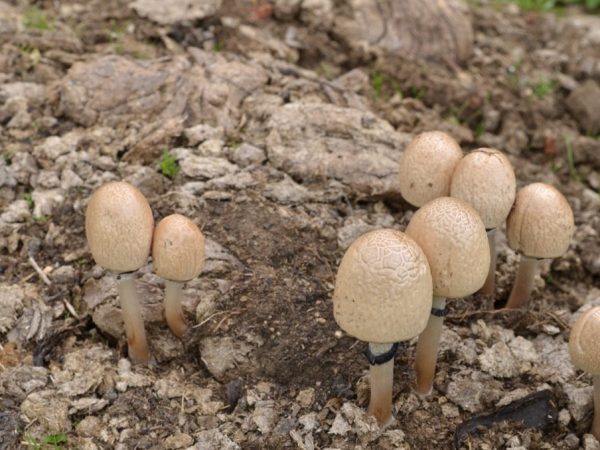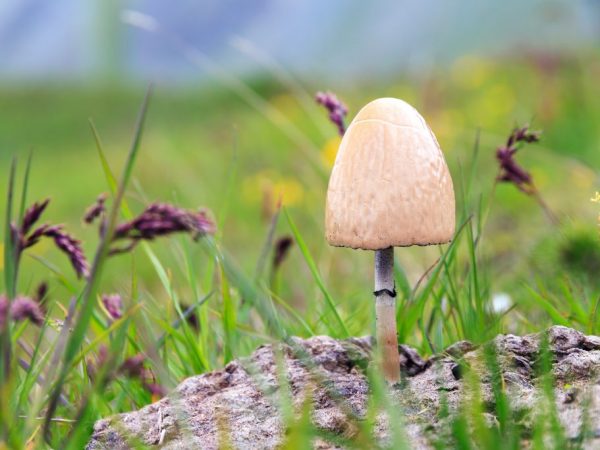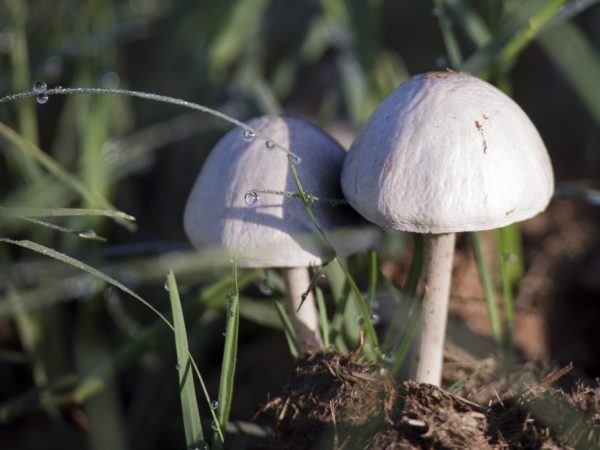Features of the fungus of the genus Dung
The dung beetle mushroom is popularly nicknamed "filthy". But this name is not entirely true - in fact, this mushroom is considered a delicacy. It belongs to the genus Dung, the order Agaricaceae, or Lamellar mushrooms. Another name is koprinus. Previously, this genus of mushrooms belonged to the Dung family, but now the species are assigned to different families (Champignon, Psatirella, etc.), because carried out at the end of the twentieth century. Phylogenetic studies have shown the heterogeneity of different dung beetle species.

Features of the mushroom variety Dung
Characteristics of the fungus
Dung beetles do not have a particularly attractive appearance, these mushrooms are classified as conditionally edible (4th flavor group).
A detailed description of the external structure includes the following features:
- the cap is gray, brown or whitish;
- the surface of the cap can be either naked or covered with scales or flakes;
- the shape of the cap is correct, resembles a cap, size up to 8 cm;
- the pulp is tender and thin;
- lamellar hymenophore; the plates forming it are at first white, but as they grow older they become inky black;
- the fruiting body is generally fine-fleshy;
- leg up to 25 cm high, up to 2 cm in diameter;
- in the center, few types of legs have a ring;
- the spores are purple or black.
At the beginning of its life, the white dung beetle mushroom has a bell-shaped hat with a brown dot in the middle. Gradually, it (the cap) increases in size and turns into a "cap". White plates of young organisms darken with age, acquire a gray tint and, when ripe, become black. A movable ring, located on a long and thin stem, is a characteristic feature of this forest organism.
Irina Selyutina (Biologist):
The generic name of mushrooms comes from the Greek "kopros", which means "manure". Mushrooms that settle on manure are called coprophiles. Coprinuses are cosmopolitan and their habitat includes, with a few exceptions, the entire territory of the Earth. You can meet them both on manure and on well-fertilized soil, crumbling stumps and other plant residues (this also applies to the territory of settlements). You can also find them in the forest - in those places where livestock graze. Smaller species of this genus abundantly cover half-decayed stumps with their fruit bodies.
Particular and general veils are often absent or disappear very quickly. In an insignificant part of the species, there is a ring (gray dung beetle) in its middle part, or at the same time - a ring and a saccular sheath at the base of the leg (white dung beetle). Sometimes the plates of the hymenophore near the pedicle grow together and form a ring-shaped thickening - a collarium.
Among the mushrooms, this is an amazing group, because dung beetles are ephemeral mushrooms.Growth and maturation occur so quickly that none of the representatives of the kingdom of the Mushrooms can compete with them in this. In small species, it is only a few hours, while in larger species it is a little longer.
Another interesting feature is rapid aging. In 1-2 days, koprinus lives its life. From snow-white, black is obtained, similar to a spread blot, containing a mass of spores. This phenomenon is usually called autolysis, autolysis - self-digestion of organisms under the influence of specific enzymes present in their cells (from ancient Greek auto - "self" and lysis - "digestion").
Description of varieties
Varieties of dung beetle:
- hairy or hairy;
- snow-white (not to be confused with white, or ink);
- home;
- woodpecker;
- shimmery;
- Romagnesi;
- grey;
- folded;
- hay.
White dung is a mushroom that differs from others and does not have similar species. Species gray dung beetle and n. home is sometimes confused with n. shimmering. White Koprinus grows in small groups, in forest parks and on dry edges.
Hairy droop
The hairy one is sometimes called "fluffy" because of the hairs, or rather, the scales on the cap and stalk. The scales on the cap are the remains of a common bedspread. It grows up to 4-5 cm and has a cap no more than 2 cm in diameter. Practically from the moment of the bell-shaped cap, the mushroom begins autolysis, during which the edges of the cap are destroyed and only its central part survives to "old age".
Belongs to inedible species, bears fruit all summer and autumn.
Home dung
It grows up to 6 cm in height and has an ellipsoidal grayish-brown cap in diameter up to 4-5 cm. This shape changes, becomes like a bell, with scars noticeable along its entire radius. The surface is covered with a white grainy coating, soft to the touch.
Refers to inedible, but not poisonous.
Woodpecker dung

Mushrooms can cause severe poisoning
The woodpecker dung beetle, or variegated dung beetle, has a weak aroma and a delicate cap with a diameter of 9-10 cm. Gradually, the edges of it break, it has a brown tint, and then completely blackens. White flakes are clearly visible on the cap - the remains of a common blanket, giving the mushroom a resemblance to the color of a forest inhabitant - a woodpecker.
This mushroom is inedible. When ingested, it causes hallucinations or problems with the gastrointestinal tract - in this matter, the opinion today is twofold, therefore it is better to refrain from eating this type of food.
Shimmering dung
Shimmering dung beetle, or crumbling dung, reaches 7 cm in height, has an ovoid medium-sized cap (up to 4 cm). On the surface there are small scales that shine, or, depending on the weather, flicker, which is the source of the species name. They shine and shimmer in the sun. However, heavy rain can completely wash them away.
This conditionally edible organism bears fruit with the onset of the first warmth before frost, and grows in deciduous forests. It is recommended to eat only young specimens.
Dunghill gray
Gray dung beetle is a mushroom with a small cap (up to 3 cm), and up to 5 cm in height. On close examination, the waviness is noticeable on the bell-shaped hat (as they say, radical, i.e. from the center to the edge).
Irina Selyutina (Biologist):
Back in the 1960s XXst. researches of French and Czech mycologists found that gray dung beetle is a good anti-alcohol agent. After a person eats these mushrooms for a rather long time, alcohol causes temporary poisoning. The active substance of gray dung beetle - tetraethylthiuramidisulfate - has the ability to oxidize alcohol entering the body through the digestive system. Then this substance was obtained synthetically and received the name "antabuse".
It is quite easy to find representatives of this species, because they grow on pastures, orchards and vegetable gardens.
It bears fruit from March to November.And it belongs to the group of conditionally edible mushrooms. It is better to eat only young mushrooms, as they have a sweetish, pleasant taste.
Scattered dung
The second name is common dung beetle. It does not grow above 3 cm. Its cap is small - only 1-1.5 cm. The color of young individuals is creamy, changing to gray with age. Even when glancing at the surface of the cap, its fold becomes clearly visible.
It belongs to inedible because of its miniature size.
Dung Romanesi
The Romanesi dung beetle has a light cap, the diameter of which is not more than 6 cm. On its surface, often located small scales are noticeable. The leg is pale gray, grows up to 4-5 cm in height.
It belongs to the group of conditionally edible mushrooms. You can use only young specimens in which the plates have not yet turned black.
Folded manure
According to the description, the folded mushroom looks like an umbrella, not fully open. It is inedible (due to the size of the fruiting body), not large in size, with a cap no more than 2.5-3 cm. Such a phenomenon as autolysis is not inherent in this species, therefore, mature plates and caps are preserved even when the spores mature.
The color of the cap is brownish-gray, its surface is folded. The leg is thin and smooth.
Hay dung
In the hay dung beetle, the cap reaches 2.5 cm in diameter, and the smooth stem is 8 cm. It is fragile and delicate in appearance. In wet weather, grooves can be seen on the surface of the cap, and in dry weather it becomes ragged and scaly. But inedible. It causes hallucinations and nervous disorders. The pulp contains the substance psilocybin.
Snow-white dung
Snow-white dung beetle has a characteristic white powdery bloom (the remains of a common blanket), which disappears after moisture gets on it. It looks like a small snowball on a summer lawn. With age, it becomes similar to a champignon, the cap is up to 3 cm in diameter. There is a characteristic swelling at the base of the stem.
It bears fruit in summer and autumn and is classified as inedible.
Beneficial features

Mushrooms lower blood sugar
In the study of a number of representatives of dung beetles, many useful properties were found, among which there are:
- the ability to normalize digestion and increase appetite;
- help stabilize blood pressure;
- natural antibiotic;
- help lower blood sugar levels in diabetes;
- have a hemostatic and antitumor effect;
- resist inflammatory processes that are caused by pathogenic microorganisms and bacteria;
Mushrooms that grow naturally contain tyrosine and histidine.
Application
Cooking applications
White dung beetle mushroom is edible and low in calories (20-22 kcal per 100 g). For cooking, only hats are used, which are well washed, drained and proceeded to the cooking process.
Young fruiting bodies can simply be fried with onions in a pan, with the addition of olive or sunflower oil and spices. The taste of the dish resembles fried champignons.
Start cooking mushrooms no later than half an hour after harvesting. Otherwise, it will simply disappear under the influence of autolysis.
Soups, borscht, stews, pilaf and pasta are prepared from conditionally edible mushrooms. They are served as a side dish for fish, they are made into a creamy sauce, etc. Dried and crushed into powder, they are added as a specific aromatic seasoning to salads or meat dishes.
Application in medicine
Ink mushroom, also known as white dung beetle, is a mushroom not included in the State Register of Medicinal Plants. But it is used to treat certain diseases:
- for the treatment of joints;
- staphylococcus;
- gangrene;
- of cardio-vascular system;
- oncology.
Application in traditional medicine
Dung beetles mushrooms (gray and white dung beetles) are used in folk medicine for the treatment of alcoholism.The composition includes protoxin coprin, which reacts with alcohol and causes the gag reflex. Gray coprinus is considered more effective.
To treat alcoholism at home, you need to take the powder of fruit bodies and add it to food or drinks. Poisoning will manifest itself with reddening of the face, severe sweating, heart palpitations and dizziness in a person who has received a dose of this peculiar medicine. After that, stomach cramps and vomiting will begin. The toxins will remain in the body for 2 days, then they will be released naturally.
The effect is manifested only when taken during a binge - there is an aversion to drinking ..
Please note! There is a danger of overdose in self-treatment for alcoholism.
Conclusion
Outwardly similar to champignon, an unattractive and even strange mushroom, it will surprise friends and acquaintances with its taste in hot dishes or snacks. When collecting, you should check if a poisonous twin has been caught.



